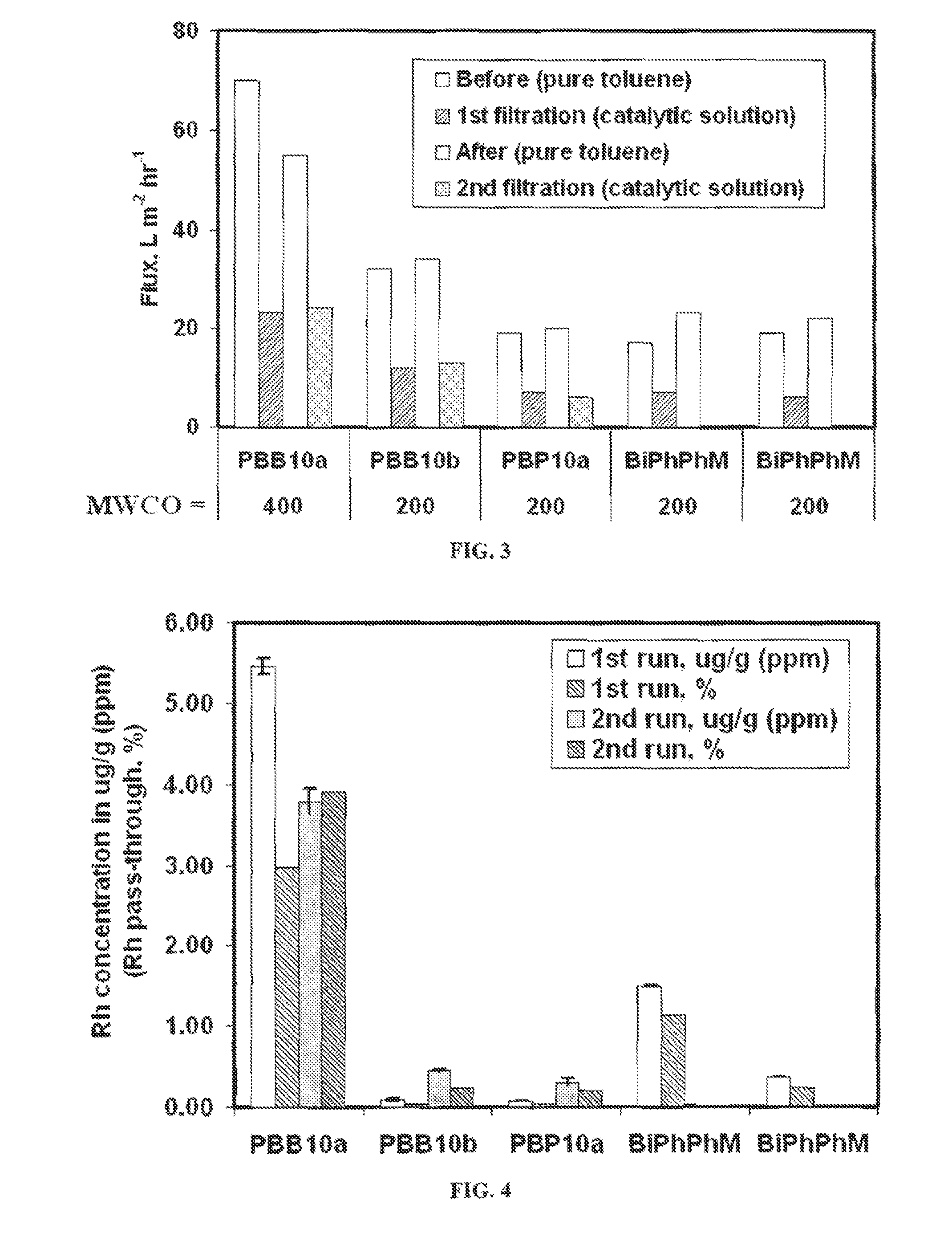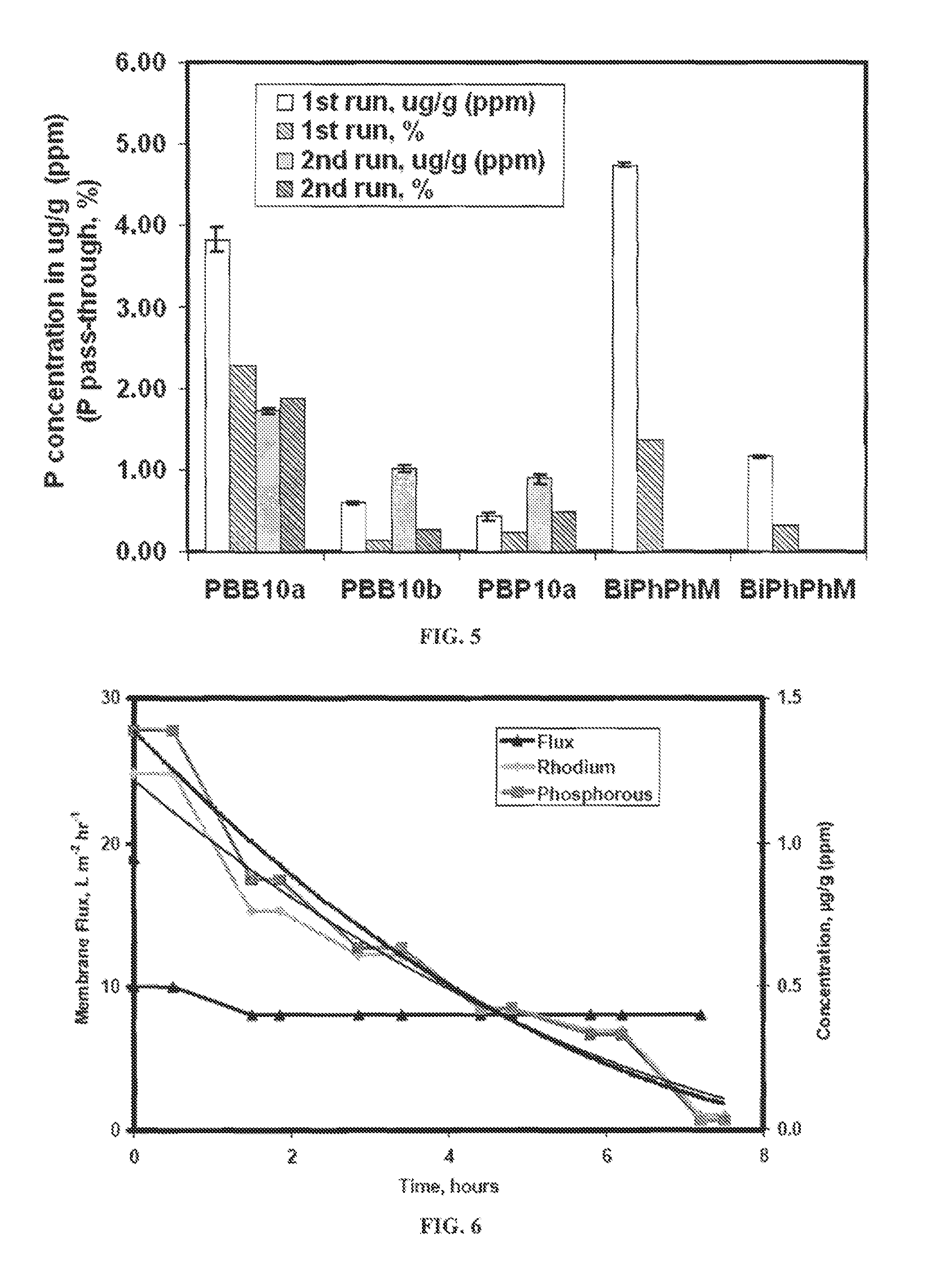Polymer-Supported Transition Metal Catalyst Complexes and Methods of Use
a technology of transition metal catalyst and complex, which is applied in the direction of organic compound/hydride/coordination complex catalyst, organic chemistry, physical/chemical process catalyst, etc., can solve the problems of commercial viability, similar problems and needs, and catalysts used in the lower olefin process, etc., to improve selectivity, improve filtration rate, and reduce viscosity
- Summary
- Abstract
- Description
- Claims
- Application Information
AI Technical Summary
Benefits of technology
Problems solved by technology
Method used
Image
Examples
example 1
Synthesis of Polymer Supported Phosphite Ligands
In this example, a well-characterized polymer having comparatively low molecular weight and a narrow molecular weight distribution (about 1.2×104 g / mol, polydispersity index=1.3) was prepared using the scheme below. Since the functional monomer (5) proved to be equally active toward polymerization as styrene, the PDI was expected to be similar to that reported for pure polystyrene. See Dollin et al., Additive Free Stable Free Radical Polymerization of Styrene, J. Polym. Sci. Part A 45 5487-5493 (2007). Control of the molecular weight and distribution was achieved by adopting a living free radical polymerization technique that is mediated by the stable nitroxyl radical, TEMPO. Conducting the copolymerization of the functional monomer (5) and styrene (1:10 ratio) at 123° C. produced a functional polymer whose ligand incorporation into the polystyrene backbone was estimated at 10% from the 1H NMR spectrum. Interestingly, end group analysi...
example 2
Synthesis of Polymer Supported Rhodium Catalyst
For the following examples, the preparation of the polymer supported rhodium catalyst was performed in toluene 12 hours prior to the hydroformylation reaction. Polymer was dissolved in dry toluene (maximum solubility 60 g / I) in an inert atmosphere and Rh(acac)(CO)2 (Rh / P=1 / 3) was added to it and stirred for overnight. The solution turns into yellowish color. The binding of the Rh with the ligand was confirmed by the 31P NMR. The change in NMR is shown in FIG. 1A and FIG. 1B.
example 3
Hydroarylation Using Polymer-Supported Rhodium Catalyst
This example concerns the use of the catalyst compositions made according to Example 2 in the catalytic hydroarylations of enones. The typical experimental procedure is straightforward and simple to operate. A mixture of enone (1 mmol) and arylboronic acid (1.3 eq.) were placed in a round bottom flask and a toluene solution (3 mL) containing Rh(acac)(CO)2 and JanaPhos as prepared in Example 2 was added to it under an inert atmosphere. Finally, a solution of methanol and water (1:1, 0.5 mL) was added to it via syringe and the resulting reaction mixture was heated at 50° C. It will be appreciated that reaction improvements have led to phosphorus loadings of 1.06 mmol / g in Example 1; however the experiments reported in this example utilized polymer with lower (0.65 mmol / g) phosphorus loading.
As can be seen from Table 1, enals, aliphatic enones, chalcones, and cyclic enones all give high yields of hydroarylation products using the c...
PUM
| Property | Measurement | Unit |
|---|---|---|
| polydispersity index | aaaaa | aaaaa |
| polydispersity index | aaaaa | aaaaa |
| volume fraction | aaaaa | aaaaa |
Abstract
Description
Claims
Application Information
 Login to View More
Login to View More - R&D
- Intellectual Property
- Life Sciences
- Materials
- Tech Scout
- Unparalleled Data Quality
- Higher Quality Content
- 60% Fewer Hallucinations
Browse by: Latest US Patents, China's latest patents, Technical Efficacy Thesaurus, Application Domain, Technology Topic, Popular Technical Reports.
© 2025 PatSnap. All rights reserved.Legal|Privacy policy|Modern Slavery Act Transparency Statement|Sitemap|About US| Contact US: help@patsnap.com



